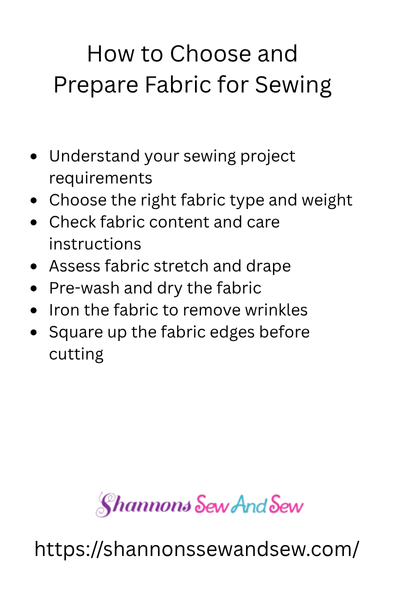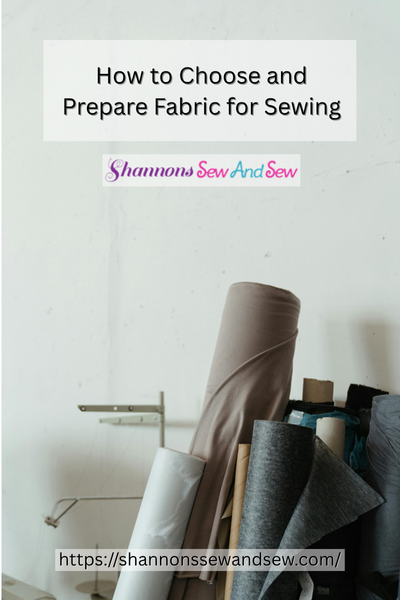Supplies And Equipment
How to Choose and Prepare Fabric for Sewing
When you’re just starting a project—or even if you’ve been sewing for years—how to choose and prepare fabric for sewing can feel like a bigger task than the sewing itself. I totally get it. I’ve stood in the middle of a fabric store with five bolts in my arms, thinking, Wait, is this too stiff? Is that one going to shrink? Do I really need to prewash everything? Spoiler alert: sometimes yes, sometimes no.
Let’s break this down together so you feel confident every time you pick up fabric and get it ready for your next masterpiece—whether it’s a pair of pants, a cosplay costume, or that pillow cover your dog’s already claimed as his.
Read More About How to Choose and Prepare Fabric for Sewing

Choosing Fabric Doesn’t Have to Be Overwhelming
So, how do you actually go about choosing and preparing fabric for sewing? First, don’t panic. It’s not a guessing game, even if it feels like it at first.
Here’s the thing: fabric isn’t just about color and print. Sure, we’re all drawn to the cool patterns (I once bought a bright shark-print cotton just because it made me laugh—no regrets), but the way the fabric feels and behaves matters just as much. If you’re sewing something structured, like a button-down shirt, you’ll want something with a bit of body like a crisp cotton or a linen blend. If it’s something comfy, like pajamas or a knit hoodie, look for jersey or fleece.
Now, there’s also weight. Not in pounds, but in drape and thickness. A lightweight rayon is going to behave very differently than a heavy denim. Want a flowy dress? Don’t go for upholstery fabric, no matter how cute the flamingos are.
And then there’s stretching. If your pattern calls for a stretch fabric and you grab a woven with zero give, you’re gonna have a bad time. Been there, done that, couldn’t sit down in the finished pants.
More Things to Know About How to Choose and Prepare Fabric for Sewing

Preparing Fabric Like a Pro (Even If You’re Just Starting)
Once you’ve picked out your fabric, it’s tempting to just lay it out and start cutting. But wait! How to choose and prepare fabric for sewing doesn’t stop at the checkout counter.
Most fabrics need to be prewashed. Why? Because they shrink. Sometimes a lot. I learned this the hard way after making a fitted t-shirt that turned into a crop top after one wash. Now, I always wash my fabric first—especially cottons and linens.
Use the same settings you plan to use when washing the final garment. If you’re going to machine wash and dry your shirt, do the same with the fabric first. That way, it shrinks before you cut and sew, not after.
If the fabric frays like crazy (I’m looking at you, rayon), toss it in a mesh bag or serge the edges before washing. That little extra step saves a ton of frustration.
And hey, don’t skip the ironing. I know, I know—it’s not fun. But ironing your fabric after washing smooths out the wrinkles and gives you way more accurate cuts. Plus, you’ll feel super professional even if your sewing table is also your kitchen table. (Guilty.)
Trust Your Hands and Eyes
The more you handle different fabrics, the more you’ll just know what feels right. Seriously, trust your instincts. Rub it between your fingers. Drape it over your arm. Ask yourself: Does this feel like what I want to wear? Will it hang the way I picture it?
I’ve bought fabrics that looked perfect on the bolt but were way too scratchy or flimsy in real life. Lesson learned: always touch before you buy. And don’t be afraid to ask for help—fabric store employees usually have awesome advice.
And if you’re shopping online? Order swatches if you can. It takes a little longer, sure, but it saves you from wasting money on a mystery fabric that turns out to be sheer polyester sadness.
What About Specialty Fabrics?
Ah, the wildcards. Things like faux leather, velvet, or chiffon. These are exciting and also, let’s be honest, a little terrifying. When it comes to how to choose and prepare fabric for sewing with these trickier materials, I always suggest doing a test run.
Sew a little sample. Try out your needles and stitches. See how it feeds through your machine. Don’t just hope it’ll work—test it and know.
I once made a vest out of faux suede and didn’t realize it hated my regular presser foot. It stuck like Velcro. A quick change to a walking foot made all the difference. You live, you learn, you share your stories so others can avoid the same mess!
How to Choose and Prepare Fabric Like a Pro
Look, sewing is a journey. You’re going to make mistakes (we all do), but knowing how to choose and prepare fabric for sewing sets you up for way more wins than losses. It’s about being curious, taking your time, and treating each project like a little adventure.
So next time you head into the fabric store or scroll through online listings, you’ve got this. Touch, test, wash, press—and most importantly, trust yourself. You’ve already taken the hardest step by asking the right questions.
And hey, if all else fails, make it a muslin and laugh about it later. I’ve got a whole box of “learning experiences” in my sewing corner. You’re not alone.




















